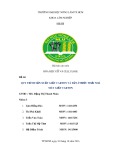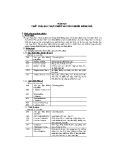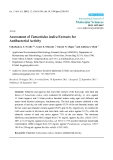Hindawi Publishing Corporation EURASIP Journal on Advances in Signal Processing Volume 2008, Article ID 273130, 11 pages doi:10.1155/2008/273130
Research Article Detection of Early Morning Daily Activities with Static Home and Wearable Wireless Sensors
Nuri Firat Ince,1, 2 Cheol-Hong Min,1 Ahmed Tewfik,1 and David Vanderpool1
1 Department of Electrical and Computer Engineering, University of Minnesota, MN 55455, USA 2 Minneapolis VA Medical Center, Department of Veterans Affairs, Minnesota, MN 55417, USA
Correspondence should be addressed to Ahmed Tewfik, tewfik@umn.edu
Received 1 March 2007; Accepted 12 July 2007
Recommended by Enis Ahmet Cetin
This paper describes a flexible, cost-effective, wireless in-home activity monitoring system for assisting patients with cognitive impairments due to traumatic brain injury (TBI). The system locates the subject with fixed home sensors and classifies early morning bathroom activities of daily living with a wearable wireless accelerometer. The system extracts time- and frequency- domain features from the accelerometer data and classifies these features with a hybrid classifier that combines Gaussian mixture models and a finite state machine. In particular, the paper establishes that despite similarities between early morning bathroom activities of daily living, it is possible to detect and classify these activities with high accuracy. It also discusses system training and provides data to show that with proper feature selection, accurate detection and classification are possible for any subject with no subject specific training.
Copyright © 2008 Nuri Firat Ince et al. This is an open access article distributed under the Creative Commons Attribution License, which permits unrestricted use, distribution, and reproduction in any medium, provided the original work is properly cited.
1.
INTRODUCTION
known to control higher cognitive functions. Therefore, TBI patients have difficulties with attention/concentration, plan- ning, memory, execution, and completion of activities.
Today, care for TBI patients is provided by health profes- sionals. Initial treatment is given at hospitals. In late recovery stages, patients are moved from the hospital and assistance is extended into the home. Wellness monitoring of the pa- tients becomes very important at this point. Unfortunately, with the shortage in care givers and rise in the number of TBI cases, it is becoming increasingly difficult to provide the required level of human monitoring and assistance that TBI patients require.
Traumatic brain injury (TBI) is one of the leading causes of death and permanent disability in the United States (US). Ac- cording to the Center for Disease Control (CDC), the num- ber of TBI patients in the US is 5.3 million [1]. About 2% of the US population has a long-term TBI and needs assistance to perform activities of daily living (ADL). This number is expected to rise with the increase in the elderly population. Males are twice as likely to sustain TBI compared to females. Furthermore, recent military actions in Iraq have led to a marked increase in TBI amongst active duty soldiers in the 18–25 age group. For example, one of a Defense and Veterans Brain Injury Center’s report indicates that 62% of patients screened between July and November of 2003 were identified as suffering from brain injury [2]. Direct medical costs and indirect costs such as lost productivity of TBI totaled an esti- mated $60 billion in the US in 2000 [3]. The system that we describe here can decrease this cost while still allowing TBI patients to lead independent and productive lives.
As indicated previously, an impact to the frontal lobe of the brain causes TBI patients to have difficulties in planning, organizing, and completing activities. To assist TBI patients in planning their daily lives, several reminder/scheduler- oriented systems have been developed. In general, these sys- tems are based on hand-held devices that deliver messages to the patient in an “open-loop” manner. For example, the plan- ning and execution assistant and trainer (PEAT) [4] provides automatic assistance for task planning. It uses an integrated task planning and execution algorithm that is a spin-off from NASA’s robotics research. Indeed, NASA’s autonomous
Traumatic brain injury is caused by a sudden impact or a penetrating injury to the head. In general, the frontal part of the brain is damaged in TBI cases. The frontal lobe is
2
EURASIP Journal on Advances in Signal Processing
Home
Fixed wireless home sensors User
can be obtained from wearable wireless sensors as previously described is missing. Our experience indicates that such in- formation is critical for accurate classification of ADLs. Fi- nally, as with the sensor systems described above, the efficacy of such reminder/planner systems has not been studied.
Intelligent reminder planner
Wearable wireless sensors Classification algorithms
Figure 1: The schematic diagram of the proposed system.
The literature provides evidence that to be useful and ef- fective, a reminder or scheduler system must accurately clas- sify and monitor the person’s activities. The two main contri- butions of this paper are establishing that it is possible to de- tect and classify activities of daily living, despite their similar- ities, with a cost effective system and that the system requires little or no subject dependent training. We focus on the prob- lems of detecting, classifying, and monitoring early morn- ing bathroom activities such as face washing, tooth brush- ing, and face shaving to provide evidence to an intelligent reminder/planner algorithm. The system uses fixed sensors to locate the subject at home and track daily activities at a coarse level. Data from a wearable accelerometer is then used to detect and classify the precise early morning bathroom ac- tivity of daily living performed by the subject. The proposed system uses IEEE 802.11 and IEEE 802.15.4 standard compli- ant wireless sensor kits. The IEEE 802.15.4 compliant wear- able sensors in particular provide low power and low data rate connectivity. They are used to monitor the execution of different activities at a detailed level. The wireless in-home fixed sensors are IEEE 802.11 compatible. In more complex systems designed to identify a larger set of activities of daily living, these fixed sensors can also be used to activate the proper wearable sensors that are best suited for recognizing activities of daily living performed in a given environment. The system uses Gaussian mixture models and a sequential classifier based on finite state machine to classify the wireless sensor data. A block diagram of the proposed architecture is shown in Figure 1.
spacecraft and rovers on Mars require the same flexibility as people to accomplish goals in uncertain and changing situ- ations. PEAT is an application of this technology on hand- held computers for the purpose of cognitive rehabilitation. PEAT and similar calendar-type systems operate on a basic alarm clock strategy that does not account for the dynamic nature of a person’s daily schedule and needs. In the recov- ery stage, TBI subjects typically remember the daily activities that they are supposed to perform. Such subjects can find repeated alarm-clock-type reminders unnecessary and an- noying. Despite its complexity and flexibility in scheduling, PEAT requires feedback from the user that could instead be provided by appropriate sensors. Within the architecture of PEAT, the monitoring of an execution of a delivered message or reminder can only be obtained by user feedback based on continuous interaction with the hand-held computer. This requires that the hand-held PC always be carried by the indi- vidual.
The paper is organized as follows. In Section 2, we de- scribe our sensor network to collect data and discuss in detail the architecture of the system. In Section 3, we explain the experimental data and our classification strategy. Finally, in Section 4, we give classification results obtained from 7 sub- jects and discuss future directions.
2.
INTEGRATION OF WIRELESS SENSOR NETWORKS FOR ACTIVITY MONITORING
Fortunately, researchers and system developers are begin- ning to focus on monitoring activities with in-home sensor networks to complement such reminder systems. In order to overcome the limitations of PEAT, a research group from the universities of Michigan and Pittsburgh has introduced a new type of planning system called Autominder [5] for cognitively impaired people. Autominder is a reminder and scheduling system involving a robot (Pearl) which has sev- eral onboard sensors to track the activity of the patients and to deliver visual and auditory messages [6] to them. How- ever, the sensor strategy used in the system has several limi- tations. First, the robot is assumed to accurately observe the actions and location of the patient. This requires the robot to be able to move to each location with the patient. This may not be practical in real life situations and may be per- ceived by patients as intrusive. Indeed, our discussions with TBI experts indicate that most patients dislike systems that produce video or intelligible audio recording of their activi- ties and are perceived as intruding on the patient’s privacy. A robot is also very conspicuous, adding to the stigma that TBI patients may feel. Second, the dynamic information which
As mentioned earlier, the data acquisition system developed at the University of Minnesota integrates two sensor systems. The first sensor system is a collection of fixed wireless sen- sors. The second system relies on wearable sensors that pro- vide data to complement the data collected by the first sys- tem. A schematic diagram of the system is given in Figure 2. Note that other designs are also possible and may offer some advantages over the system that we constructed. For example, a system that relies exclusively on wearable sensors would be easier and cheaper to deploy. Such a system would substitute accurate localization based on wireless transmis- sions for the inputs obtained from the fixed wireless system that we are using. In most of the systems that we have inves- tigated, accurate localization from wireless signal measure- ments requires using more than one base station and in some
Nuri Firat Ince et al.
3
IEEE 802 11 Home sensors
• Motion • Door • Pressure
USB eN
PC
cur. In addition, some activities may trigger the same sen- sors. For instance, the subject may enter the bathroom for a washing or brushing activity. During these two activities, the same subset of sensors is activated which makes it difficult to distinguish between wash and brush activities by examining the binary sensor data of the eN.
• Light • Acc. • Mag. • Temp. • Acous.
RS-232 MIB510
IEEE 802 15.4 Wearable sensors
Figure 2: The data acquisition platform which combines static home and wearable wireless sensors.
cases extensive signal strength surveys across a home, negat- ing the savings achieved by not installing the fixed sensors.
2.1. Static in-home wireless sensors
To get detailed information about the activity of the patient, we use wearable sensors attached to the wrist and installed on a wireless networked embedded system (see Figure 3(d)). In particular, we selected the MICAz wireless nodes developed by Crossbow Technology Inc. (www.xbow.com) for wearable data collection. Data trans- mission and reception on the MICAz is handled by a Chip- con CC2420 radio chip, which is IEEE 802.15.4 compliant. It has a 250 Kbps radio throughput rate. The onboard expan- sion slot enables the designer to interface several sensors to the microprocessor. The microprocessor runs TinyOS 1.1.7, a small open source operating system for the embedded sen- sor networks. The microprocessor is programmed with the NesC programming language to collect and transmit the sen- sor readings to the PC. NesC is a new programming environ- ment for networked embedded systems. It significantly sim- plifies the efforts for application development under TinyOS (www.tinyos.net).
In our system, we used the MTS310 multisensor board to record movement and environmental parameters. The MTS310 has onboard light sensors, temperature sensors, a 2-axis accelerometer, a 2-axis magnetometer, and a micro- phone. These sensors are connected to the multichannel 10- bit ADC of the mote kit.
In this paper, we will restrict ourselves to the presentation and analysis of accelerometer data. The onboard sensor is an Analog Devices ADXL202JE dual-axis accelerometer.
The use of accelerometers for activity recognition is not new. Initial applications of accelerometers have concentrated on the recognition of sitting, standing, and walking behav- ior [9]. The system of [9] used two biaxial accelerometers at- tached to waist and leg to estimate body position and lower- limb gestures. The accelerometer sensors are wired to a PDA for data collection. The wiring is a critical issue which lim- its the user activity in real life situations. In another system that consists of five biaxial accelerometers attached to several locations on the body has been used for activity recognition [10]. In order to remove the wirings between the sensors and data center, the system used hoarder boards. The data was lo- cally stored with time stamps on these boards and post pro- cessed offline for synchronization and classification. By using decision tree classifiers, the system was able to recognize 20 everyday activities with an overall accuracy rate of 84%. The studies of [9, 10] showed that the flexible data collection is a critical step to give the subject the freedom to do his/her daily activities.
Many technologies have been developed for in-home activ- ity monitoring. Most of these technologies use static home sensors which are activated by the user [7, 8]. These include thermistors positioned under the bed to measure body mo- tion, infrared sensors to detect the presence of the subject in a specific location, magnetic sensors attached to appliances to detect their use, and so forth. The use of such sensors gives strong clues about the individual’s location and activ- ities being performed. However, the wiring between the sen- sors and data center is a major issue for such a system. In our study, we elected to use eNeighbor (eN), a wireless remote in-home activity monitoring system which was recently de- veloped by RedWing Technologies and is currently marketed under the name Healthsense (www.healthsense.com). The eN wireless sensor network is based on the IEEE 802.11 stan- dard. It has an Atmel Mega 128 microprocessor and includes server technology applications for externally alerting and re- porting monitoring information. An IEEE 802.15.4 network standard-based version of eN will also be available soon. This system comes with several sensors such as motion, bed, chair, and door sensors that enable it to track a broad range of daily activities at a coarse level as shown in Figure 3. Each sensor communicates with the base station only in the case of an event. Therefore, the sensors have long battery life and can be used at home without maintenance for long periods of time. Each event received by the base station is exported in real time through the USB port to an external device for backup. We have developed a USB port driver to capture the messages transmitted from the base station and save these messages on a PC with a time stamp to synchronize with the other sensors in the remaining system.
2.2. Wearable wireless sensors
The eN gives binary information that provides clues about the activities carried out by the individual. There are many activities where interactions with these sensors do not oc-
In order to transfer accelerometer data to the PC we used an MIB510 serial getaway. The MICAz mote communicates with the MIB510 gateway using a wireless IEEE 802.15.4 link. The gateway transmits the received sensor readings to the PC through an RS-232 port. In the current system, the data com- munication rate is limited to 56 Kbps on the RS-232 side. This data rate was high enough to transmit data from the
4
EURASIP Journal on Advances in Signal Processing
Kitchen
Corridor
Livingroom
m o o r h t a B
Bedroom TV
Sensors
Pressure Motion
Door Contact (b) (a)
Bed Bdrm Mot Bdrm Dr Cor Mot Bath Dr Bath Mot
Time (c) (d)
Figure 3: (a) The static home sensors; from left to right: door sensor, base station, and motion sensor. (b) A typical in-home setting of static home sensors. (c) In-home sensor data transmitted from the base station to the PC while a subject is moving from the bedroom to the bathroom. (d) Wearable wireless sensor kit attached to the right wrist.
sensors since the sensors outputs are sampled at the rate of 50 samples/s. The reader can find detailed information about the data acquisition system in [11].
our case. This allows us to constrain the list of most likely ac- tivities that the subject may be executing. In phase II, we rely on the wearable accelerometer sensor to detect, classify, and monitor the progress of ADLs. In this phase, we rely only on accelerometer data.
3.1. Early morning ADL data
On the PC side, we developed another serial port driver to capture the packets received from the MIB510 gateway. We saved the sensor readings in an ASCII file with time stamps similar to those used by the eN system for further processing. We developed software to capture the serial messages trans- mitted by the eN system and the MIB510 using ActiveX com- ponents built on top the MS Windows application program- ming interface (WINAPI). This could have also been done using the Matlab (MathWorks Inc, Natick, Mass, USA) se- rial line programming interface in order to bypass detailed WINAPI.
3. DETECTION OF ACTIVITIES OF DAILY LIVING
ADLs can be classified into 3 different categories: basic, in- strumental, and enhanced ADL. According to [12], basic ADL deals with personal hygiene and nutrition such as wash- ing, toileting, and eating. The authors state that all people living independently should be able to execute these basic ADLs. Instrumental activities can be managing a medica- tion intake, maintaining a household, and so forth, while en- hanced ADLs involve activities outside one’s residence and social interactions. We have selected several basic early morn- ing ADLs for initial investigation.
Let us now describe the data that we collected to design and test the system, explain the classification procedure we con- structed, and discuss system training.
As mentioned earlier, the system that we developed re- lies on a two-phase approach for detecting, classifying, and monitoring ADLs. In phase I, we localize the subject within a specific room of a home and perhaps on a specific piece of furniture using the fixed wireless sensors, for example, eN in
Our initial studies and system design are based on healthy subjects since data collection from TBI patients is difficult and most TBI patients do not have any upper limb disabil- ity preventing them from carrying out their early morning ADLs. We will continue to design, refine, and test the system with data collected from healthy subjects. Once we achieve
Nuri Firat Ince et al.
5
Table 1: Available trials.
Activity Trials
Brush Wash 199 182
Shave 107
OAct 40
an acceptable performance level, we will test our system on TBI patients and refine it further.
3.1.1. Data collection
when engaged with a specific task. Furthermore, the number of mixtures can account for variability across subjects as well. We extracted time-domain (TD) and frequency-domain (FD) features from the accelerometer data which were in- put to the GMM. The 2-axis accelerometer sensor provides two types of outputs for each channel. The DC component of the accelerometer sensor is related to the tilt information and the AC component is related to the acceleration signals. The time-domain features are extracted from raw data. We believe that it reflects the hand position. Frequency-domain features are extracted from the AC component measurement. Therefore, we combine both feature sets in the final classifi- cation. The time-domain features consist of the mean, root mean square, and the number of zero crossings in a 64 sam- ple time segment. After applying a first-order high-pass But- terworth filter, we calculate the frequency-domain features for the AC component of the acceleration signal. We extend the feature set with energies in different frequency bands. The Fourier transforms of the accelerometer data along the two axes are calculated from each 64 sample time segments along with the time-domain features. The time segments are shifted with 50% overlap across the signal. In each segment, we calculate the energy in dyadic frequency bands as in- dicated in Figure 5(b). Frequency-domain features are then converted to log scale and combined with time-domain fea- tures related to the same time segment. This resulting feature vector x has a dimension of 16 in each time segment [15].
3.2.2. GMM classifier and preliminary decision
A GMM probability density function (pdf) is defined as a weighted combination of N Gaussians:
In this paper, we focus in particular on the classification of three ADLs. These are face washing, tooth brushing, and face shaving. The data was recorded from seven healthy subjects with the system described above. A single mote kit is attached to the wrist to record hand movements. After a small train- ing period, the wireless sensor system and user friendly data acquisition software installed on a notebook PC were given to the subjects to record the ADL data in their home setting. For privacy reasons, no audio or video data were recorded. In order to provide the ground truth for recorded wearable and static home sensor data, we conducted a single trial based recording paradigm. The subjects freely executed one of the three early morning activities listed above and the data were labeled manually after each recording. The number of avail- able trials for each activity is given in Table 1. Sample signals corresponding to these activities are shown in Figure 4. In addition to the 3 distinct activities, subjects were also asked to record data related to activities that have no specific pur- pose or do not correspond to the three early morning activ- ities listed above. Examples of such activities include chang- ing a towel, arranging items on the sink. All such activities are categorized as other-activity (OAct).
N(cid:4)
(cid:3)
=
(cid:3) ,
(1)
k = 1, . . . , K.
p
(cid:2) x | λk
(cid:2) x | μc, Σc
wcη
c=1
Here, λk is the model, x is the feature vector, η is the D- dimensional Gaussian pdf:
(cid:6)
During the data collection process, subjects reported that tooth brushing and face shaving were generally preceded and followed by a face wash activity. Although we attempted to record a single activity, many tooth brushing and face shav- ing recordings included a short duration of face washing. Therefore, in our final decision evaluation, we ignored wash- ing outputs when they are observed just before and after tooth brushing and face shaving activities.
(cid:2)
(cid:3)
(cid:3)
(cid:7) (cid:3)
=
η
μc, Σc
(cid:2) x − μc
(cid:2) x − μc
T Σ−1 c
(cid:5) (cid:5)1/2 exp
− 1 2
1 (cid:5) (cid:5)Σc (2π)D/2
3.2. Classification of early morning ADL data
(2)
3.2.1.
Feature extraction
with mean vector μ and covariance matrix Σ. Parameter wc is the weight of each component and satisfies
N(cid:4)
(3)
wc = 1.
c=1
A new observed feature vector can be assigned to one of the four classes (K = 4) after evaluating the posterior prob- ability of each GMM. Specifically, the label L assigned to an observed vector x is calculated as
(cid:2)
(cid:3)(cid:3) ,
(4)
p
k = 1, . . . , K.
L = arg max
(cid:2) x | λk
There are several possibilities for generating activity state models and ADL classification methods. In this study, we use a hierarchical classification system as indicated in Figure 5 because of its simplicity and performance. The system com- bines Gaussian mixture models (GMM) and a sequential classifier. We use GMMs to model the activities such as tooth brushing, face washing, and face shaving. GMMs are widely used in continuous classification of EMG signals for pros- thetic control and speaker identification problems due to their robustness and low computational complexity [13, 14]. The main motivation of using a GMM is that it provides a generative model of each task. The mixtures in the model are believed to represent the sub activities executed by the subject
k
6
EURASIP Journal on Advances in Signal Processing
900 900 900
s g n i d a e r C D A n o i t a r e l e c c A
s g n i d a e r C D A n o i t a r e l e c c A
s g n i d a e r C D A n o i t a r e l e c c A
500 500 500
50 50 50 0 1 2 3 4 5 2 3 2 4 6 8 1 2.5 0.5 6 ×103 3.5 ×103 10 ×103 Samples 1.5 Samples Samples
Ax Ay Ax Ay Ax Ay (a) (b) (c)
Figure 4: Typical recordings obtained from 2-channel accelerometer sensor (Ax and Ay) attached to the right wrist; (a) tooth brushing, (b) face washing, and (c) face shaving.
Bayesian classifier to smooth the GMM outputs. Specifically, we compute
(cid:8)
=
p
i = 1, 2, . . . , 8,
pN k
(cid:2) xi | λk (cid:2)
(cid:3) , (cid:3)
(5)
,
k = 1, . . . , K.
i L = arg max
pN k
k
Model order selection plays a big role in determining the performance in GMM based systems. While a low number of mixtures can poorly represent the geometry of the activity in a D-dimensional space, a high number of mixtures generally over fit the data. We have found that by varying the number of mixtures from 1 to 6 we are able to find the optimal value for classification.
3.2.3. Postprocessing and final decision
× PrL
(6)
,
postN L
× Prk
We calculate the posterior probabilities of each naive Bayesian classifier and then convert them to discrete symbols V that are processed by a sequential classifier. We remove ob- servations which have low posterior probability at the input stage of the sequential classifier. Specifically, we use = pN L (cid:9) k pN k
⎧ ⎪⎨
L if postN
L > 0.7,
(7)
V =
⎪⎩
0
else,
The evaluation in (4) gives a class label for each time point. This corresponds to the continuous classification of the streaming data from the sensors. However, we noticed that the arm movements during each task contain many sub- segments where the activity is not locally related to the task being executed. In addition, as we emphasized before, a sin- gle task can be executed by visiting many subtasks that also involve the 3 activities we focus on. For example, a face shav- ing task may start with face washing, then applying cream to the face, shaving with the razor, and at the end again wash- ing the face. Therefore, the GMM outputs give many local outputs that cause a high false positive recognition rate. In our previous work, we utilized a fixed window majority voter (MV) procedure to remove local errors [15]. The majority voter used 16 points (∼=10 s) windows to decide whether the observation sequence is related to any of the tasks of interest. Although several time points were used for voting, we no- ticed that the classifier performed poorly during state tran- sitions. We also noticed that the execution times of the three tasks that we are studying were quite different. A fixed win- dow size does not provide enough flexibility to deal with these differences.
where post N is the naive Bayesian classifier posterior prob- k ability of Brush = 1, Wash = 2, Shave = 3, and OAct = 4 nodes, PrL is the prior probability of each task and V is the input labels to the sequential classifier. Equation (7) removes outputs with low probabilities that occur at the beginning and end of each task, since these correspond to time intervals where uncertainty is high. This stage also converts the con- tinuous input sequence to discrete labels such as B = 1, W = 2, S = 3, OAct = 4, and no surviving activity—NoAct = 0}. These discrete inputs from the wash, brush, shave, and OAct nodes are processed by the sequential classifier as indicated in Figure 7. The sequential classifier essentially tracks the states by counting the labels in the input sequence and deciding whether the resulting sequence is related to one of the 4 tasks that we study. If not, it provides a NoAct output. Note that, rather than using a fixed window size majority voter, the sequential classifier provides a state tracking capability and flexibility in the task specific selection of the processing win- dow size. Since we do not know where the real activity starts
To improve performance, we used a sequential classifier that acts as a finite state machine (FSM) as described below. Instead of calculating the posterior probabilities for each fea- ture vector on the GMM outputs, first we evaluate the out- put probabilities over an 8-point time window with a naive
Nuri Firat Ince et al.
7
Table 2: Classification accuracies of different feature sets (%).
Sequential classifier
Wash Brush Shave GMM GMM GMM
Features TD FD TD + FD
OAct 95 97.5 95
Brush 83.5 96.7 95.6
Wash 67.8 16.6 93.5
Shave 74.2 12.1 92.5
· · ·
· · ·
· · ·
· · ·
Frequency domain Time domain
2-axis wearable accelerometer data
(a)
400
can miss this when it is run in the beginning of a task. In the transition regions between states, the HMM may then pro- vide several local errors. On the other hand, the sequential detector implements a sequential test. It waits until enough evidence has been collected before making a final decision. When an input is observed, it waits until the system classifies the next state which will give further information about what task is/was being executed. For example, if a tooth brushing input is observed, the system waits to see if the next state is putting cream/shaving, in which case it would classify the en- tire activity as face shaving rather than tooth brushing.
300
4. RESULTS
e d u t i n g a m d e g a r e v A
200
100
0 0 5 10 15 20 25 Frequency (Hz)
Brush Shave Wash (b)
In order to evaluate the performance of the extracted time- domain and frequency-domain features and their combina- tion in classification, we conducted several “leave one sub- ject out” (LOSO) experiments. In particular, we collected data from 7 subjects and used the data of one of them for testing and the remaining subjects’ data for training the sys- tem. This procedure was repeated for all 7 subjects to ob- tain classification performance and was averaged to obtain overall classification accuracy. The classification results ob- tained with the LOSO method provide information about the subject generalization capability of the proposed system. Table 2 provides classification results for time-domain fea- tures, frequency-domain features, and their combination.
The combination of
Figure 5: (a) The schematic diagram of the proposed classification system which is based on GMM followed by a sequential classifier. (b) The dyadic frequency bands used to extract frequency-domain features.
and ends, the sequential classifier provides great flexibility and accounts for the temporal variability in the data.
time-domain and frequency- domain features yields better classification performance than using time-domain or frequency-domain features alone. This suggests that the acceleration and the arm’s tilt data carry significant information for activity recognition. In ad- dition, the classification performance of the technique se- quential classifier was better than the majority voter ap- proach. The classification results for different number of mixtures are given in Tables 3 and 4 for the sequential classi- fier and majority voter approaches. We noticed that the best classification accuracy is obtained with 2 mixtures for se- quential classifier and majority voter approaches. Increasing the number of mixtures for both approaches decreased the classification accuracy. A higher number of mixtures may re- sult in over learning in the GMM stage. We believe that a low number of mixtures provide smoothness and enhance the correctness of the classifier. The confusion matrices re- lated to the best mixture indexes for the sequential-classifier- and majority-voter-based approaches are given in Tables 5 and 6, respectively.
In a similar study, a hidden Markov model- (HMM-) based approach has been used for activity modeling [16]. The authors have used a fixed size time window HMM and shifted the window along the signal to get classification out- puts. In our study, the sequential classifier works without any window size limitation on the observed sequence. The win- dow sizes for a particular activity are adjusted to subject dif- ferences. In our experimental studies, we observed that in most cases the washing activity takes much less time than the tooth brushing and face shaving activities. Furthermore, many segments of activities may involve similar movement of the arm. For instance, if a subject engages in the face shav- ing task, we often obtain brush labels in the beginning of the task due to common movement patterns between applying shaving cream to the face and tooth brushing. Both activities include circular hand movements which induces oscillatory components in the accelerometer sensor. A fixed size HMM
As mentioned earlier, in our experimental studies we no- ticed that there is a significant overlap in the feature space between the activities of tooth brushing, putting soap, and applying shaving cream to the face. All of these segments
8
EURASIP Journal on Advances in Signal Processing
5 2
4 OAct Putting soap
Shave 3
s e t a t S
2 1 Wash
y t i l i b a b o r p r o i r e t s o P
1 Brush
0 UCAct
−1
0 5 10 15 20 25 30 35 40 45 50 0 0 5 10 15 20 25 30 35 40 45 50 Time (s) Time (s)
BrushGMM WashGMM ShaveGMM OActGMM (b) (a)
2 5
4 OAct
Shave 3
s e t a t S
1 2 Wash
y t i l i b a b o r p r o i r e t s o P
1 Brush
0 UCAct
−1
0 0 10 20 30 40 50 60 70 0 10 20 30 40 50 60 70 Time (s) Time (s)
Brush Wash Shave OAct (d) (c)
Figure 6: (a) The Bayesian posterior probabilities of the classifiers during a washing task. (b) The input votes (V ) entering the sequential detector. Note that the putting soap section is locally classified as tooth brushing. (c) The Bayesian posterior probabilities related to brush activity and the input votes entering the sequential detector (d). Note that tooth brushing task is followed by a washing activity due to giving rinse. They are ignored in final evaluation (UCAct = NoAct).
Table 4: Classification accuracies (%) obtained from TD+FD com- bination with majority voter post processing. The NoMix stands for the number of mixtures in GMM.
Table 3: Classification accuracies (%) obtained from TD + FD combination with sequential classifier post processing. The NoMix stands for the number of mixtures in GMM.
NoMix 1 2 3 4 5 6
Brush 96.7 95.6 95.1 96.2 92.3 95.1
Wash 77.4 93.5 89.4 87.9 86.9 87.4
Shave 82.2 92.5 91.6 88.8 87.9 89.7
OAct 97.5 95 95 95 95 95
NoMix 1 2 3 4 5 6
Brush 98.4 95.6 95.1 93.4 92.8 95.1
Wash 79.9 87.9 89.4 85.4 85.4 83.4
Shave 68.2 87.9 84.1 83.1 83.1 85.3
OAct 92.5 90 90 92.5 92.5 92.5
shown in Figure 6. The sequential classifier eliminated many of these false positives by using different time window thresh- olds. For the brushing activity, a higher brush count (BC) is used for final decision.
include circular hand movements that cause sinusoidal wave- forms in the accelerometer. As can be seen from the confu- sion matrices, the face washing and face shaving activities are mostly classified as tooth brushing in these regions. In par- ticular, putting soap or applying shaving cream is locally rec- ognized as a tooth brushing activity. A representative trial is
It should be noted that in our final evaluation of the classification performance, face washing outputs preceding
Nuri Firat Ince et al.
9
Table 5: The confusion matrix for TD + FD combination and se- quential classifier postprocessing for NoMix = 2.
Discrete input sequence (V ): NNNNWWWBBBBWWWWWWWWWWWWWWWWNNNN
The FSM based sequential classifier.
Tasks Brush Wash Shave NoAct
Brush 174 8 5 0
Wash 1 186 2 0
Shave 3 1 99 2
OAct 4 4 1 38
Accept Accept B W
Table 6: The confusion matrix for TD + FD combination and ma- jority voter postprocessing for NoMix = 2.
Accept Accept S OA
Tasks Brush Wash Shave NoAct
Brush 174 11 11 0
Wash 0 178 0 1
Shave 0 2 96 3
OAct 8 8 0 36
Transition rules: Bc > 8, Reset(Wc, Sc,OAc) Wc > 8, Reset(Bc, Sc,OAc) Sc > 8, Reset(Bc, Wc,OAc) OAc > 8, Reset(Bc, Wc,Sc)
Bc > 15, Set(TS = B) Wc > 15, Set(TS = W) Sc > 15, Set(TS = S) OAc > 15, Set(TS = OA)
Decision rules: Brush accept: Bc > 32 or (TS = B and Nc > 15) Wash accept: Wc > 20 or (TS = W and Nc > 15) Shave accept: Sc > 20 or (TS = S and Nc > 15) OAct accept: OAc > 15
Wc = wash count, Sc = shave count, Bc = brush count, OAc = other activity count, Nc = no surviving activity count TS = temporary state




































